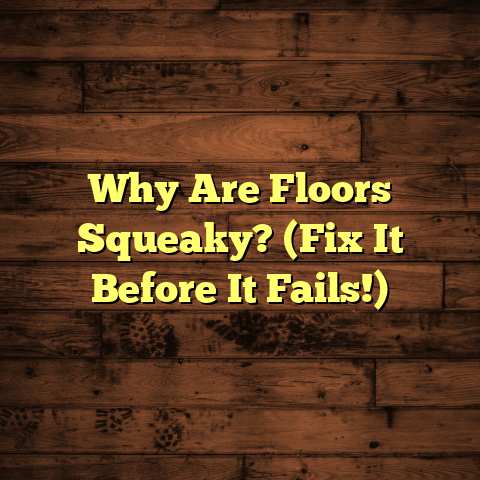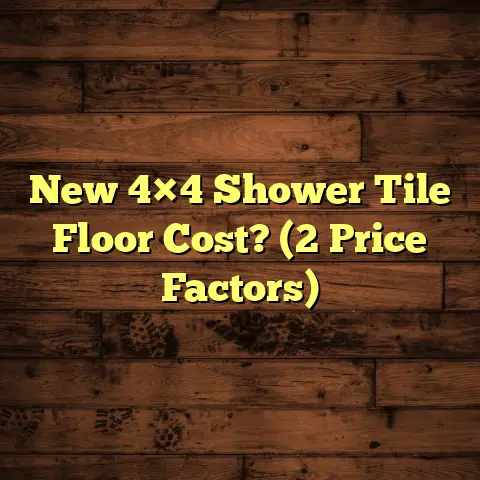Wood-Look Stick Tiles: Cheap But Worth It? (2 Secrets!)
Lately, wood-look stick tiles have been making waves, and for good reason.
They offer a budget-friendly way to get that classic hardwood aesthetic without breaking the bank.
Plus, many options boast waterproof capabilities, a game-changer for high-moisture areas.
But are they really worth it?
Can a “cheap” flooring option truly stand the test of time and look good doing it?
In this article, I’m going to dive deep into the world of wood-look stick tiles, revealing two crucial secrets that can make or break your flooring decision.
Let’s get started!
Understanding Wood-Look Stick Tiles
So, what exactly are these wood-look stick tiles?
Essentially, they’re thin, flexible tiles made from materials like vinyl or laminate, designed to mimic the appearance of real wood.
The magic lies in the manufacturing process.
Advanced printing technology creates realistic wood grain patterns, complete with knots, variations, and even textures that fool the eye.
I’ve seen some that are so convincing, clients have to touch them to believe they’re not real wood!
How do they stack up against traditional hardwood?
Well, let’s break it down:
| Feature | Wood-Look Stick Tiles | Traditional Hardwood |
|---|---|---|
| Cost | Lower | Higher |
| Installation | Easier (DIY-friendly) | More complex |
| Maintenance | Simpler | More demanding |
| Waterproof | Often available | Typically not |
| Durability | Moderate | High |
As you can see, stick tiles offer significant advantages in terms of cost and ease of installation.
However, hardwood generally wins out in terms of long-term durability and overall lifespan.
But don’t write off stick tiles just yet!
The variety of styles and finishes available is truly impressive.
You can find everything from rustic farmhouse looks to sleek, modern designs, allowing you to perfectly match your existing décor.
The Waterproof Advantage
Okay, let’s talk about the real selling point for many homeowners: waterproof capabilities.
Think about it: kitchens, bathrooms, basements – these are all areas prone to spills, leaks, and general moisture.
Traditional hardwood in these spaces?
A recipe for disaster!
Waterproof wood-look stick tiles, on the other hand, are specifically designed to withstand these conditions.
The benefits are huge:
- Easy Cleaning: Spills wipe up effortlessly, no need to worry about staining or warping.
- Mold & Mildew Resistance: Waterproof materials prevent the growth of harmful mold and mildew, creating a healthier living environment.
- Longevity: By preventing water damage, these tiles can last much longer than other flooring options in moisture-prone areas.
I’ve personally installed waterproof stick tiles in numerous bathrooms, and the feedback has been overwhelmingly positive.
Clients rave about the ease of cleaning and the peace of mind knowing their floors are protected.
For example, I recently used [Brand Name] Waterproof Vinyl Plank Tiles in a basement renovation.
These tiles boast a 100% waterproof core and a durable wear layer, making them ideal for a potentially damp environment.
The client was thrilled with the results, saying the tiles completely transformed the space and eliminated their worries about water damage.
Cost-Effectiveness and Value
Now, let’s get down to brass tacks: how much do these things actually cost?
Compared to traditional hardwood, wood-look stick tiles are significantly more affordable.
Here’s a general cost breakdown:
| Flooring Type | Material Cost (per sq ft) | Installation Cost (per sq ft) |
|---|---|---|
| Wood-Look Stick Tiles | \$1 – \$4 | \$1 – \$3 |
| Traditional Hardwood | \$5 – \$15 | \$4 – \$8 |
As you can see, you can save a considerable amount of money on both materials and installation.
And speaking of installation, this is where stick tiles really shine.
Their peel-and-stick design makes them incredibly DIY-friendly, potentially saving you hundreds or even thousands of dollars in labor costs.
I’ve had clients with zero prior flooring experience successfully install stick tiles in their homes.
Of course, professional installation is always an option, and it can ensure a perfect, long-lasting result.
But for budget-conscious homeowners, the DIY potential of stick tiles is a major draw.
But what about long-term value?
Do stick tiles hold up over time, and can they potentially increase your home’s resale value?
While they may not have the same prestige as hardwood, well-maintained wood-look stick tiles can definitely add value to your home.
Their durability and waterproof capabilities make them a practical choice for families with kids or pets, and their aesthetic appeal can enhance the overall look and feel of your home.
And now, for the first secret I promised you:
Secret #1: Brand Matters!
Not all wood-look stick tiles are created equal.
Choosing the right brand can have a huge impact on the overall quality, durability, and appearance of your flooring.
I’ve seen firsthand the difference between cheap, flimsy tiles and high-quality, well-made ones.
The cheap ones tend to peel, crack, and fade quickly, while the better brands can last for years with proper care.
Do your research, read reviews, and don’t be afraid to spend a little more for a reputable brand.
Trust me, it’s worth the investment in the long run.
Installation and Maintenance
Alright, let’s talk about getting these tiles installed and keeping them looking their best.
Here’s a simplified guide to the installation process:
- Prepare the Surface: Ensure the subfloor is clean, level, and dry. Remove any existing flooring or debris.
- Measure and Plan: Calculate the amount of tile needed and plan the layout, taking into account any obstacles or corners.
- Apply Adhesive (if needed): Some stick tiles come with pre-applied adhesive, while others require a separate adhesive. Follow the manufacturer’s instructions carefully.
- Place the Tiles: Carefully align each tile and press firmly into place. Use a roller to ensure proper adhesion.
- Cut as Needed: Use a utility knife or tile cutter to trim tiles to fit around edges and obstacles.
- Clean Up: Remove any excess adhesive or debris.
Tools You’ll Need:
- Utility knife or tile cutter
- Measuring tape
- Level
- Roller
- Straightedge
- Gloves
- Safety glasses
As I mentioned earlier, the installation process is relatively straightforward, making it a great option for DIY enthusiasts.
However, if you’re not comfortable with home improvement projects, or if you have a large or complex space, professional installation is always a good idea.
Now, let’s move on to maintenance.
The key to keeping your wood-look stick tiles looking their best is regular cleaning and proper care.
Here are some tips:
- Sweep or vacuum regularly: Remove dirt and debris to prevent scratching.
- Mop with a damp cloth: Use a mild detergent and avoid excessive water.
- Avoid harsh chemicals: Harsh cleaning products can damage the tile’s surface.
- Use floor protectors: Place felt pads under furniture legs to prevent scratches.
- Clean spills immediately: Wipe up spills as soon as they happen to prevent staining.
And now, for the second secret:
Secret #2: Maintenance Matters!
Proper maintenance is crucial for extending the life and appearance of your wood-look stick tiles.
Neglecting your floors can lead to premature wear and tear, fading, and even peeling.
By following the simple maintenance tips I outlined above, you can keep your floors looking beautiful for years to come.
I’ve seen clients who have had their stick tiles for over a decade, and they still look fantastic because they took the time to properly care for them.
Aesthetic Versatility
One of the things I love most about wood-look stick tiles is their aesthetic versatility.
They can seamlessly blend into a variety of interior styles, from traditional to modern and everything in between.
Whether you’re going for a rustic farmhouse vibe or a sleek, minimalist look, there’s a wood-look stick tile to match your vision.
They’re also incredibly versatile in terms of placement.
While they’re commonly used as flooring, they can also be used to create stunning accent walls or even backsplashes.
I recently worked on a project where we used wood-look stick tiles to create a feature wall in a living room.
The result was absolutely stunning, adding warmth, texture, and visual interest to the space.
I’ve also seen stick tiles used creatively in kitchens, bathrooms, and even entryways.
The possibilities are truly endless!
Here are some design ideas to get you inspired:
- Rustic Farmhouse: Choose tiles with a distressed wood grain pattern and a matte finish.
- Modern Minimalist: Opt for sleek, light-colored tiles with a smooth surface.
- Coastal Chic: Go for whitewashed or gray-toned tiles to create a beachy vibe.
- Industrial Loft: Use dark, weathered-looking tiles to add character and depth.
Conclusion
So, are wood-look stick tiles cheap but worth it?
In my professional opinion, the answer is a resounding yes – with a few caveats.
Their waterproof capabilities, cost-effectiveness, and aesthetic versatility make them a compelling flooring option for many homeowners.
However, it’s crucial to remember the two secrets I shared with you:
- Brand Matters: Choose a reputable brand to ensure quality and durability.
- Maintenance Matters: Properly care for your floors to extend their lifespan and appearance.
By keeping these secrets in mind, you can confidently choose wood-look stick tiles for your home and enjoy their many benefits for years to come.
I encourage you to explore the possibilities of wood-look stick tiles in your own home.
They’re a worthwhile investment that can transform your space and enhance your lifestyle.
Happy flooring!





